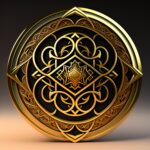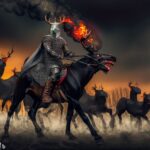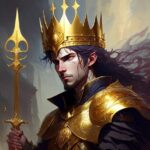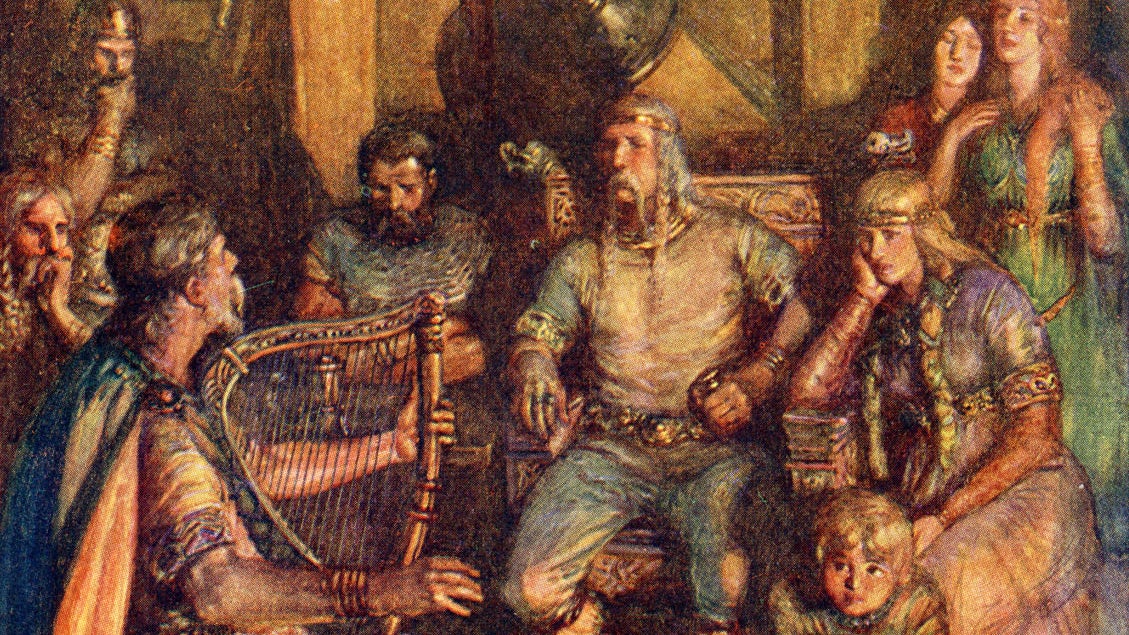 The Sonaide Bri are a human culture that spans countless tiny kingdoms and principalities united by a common culture, beliefs and traditions, religion, and language (before the advent of the Common Tongue about three millennia ago). They worship the Áes Camáir, the Children of Dawn: five gods and their descendants who are directly descended from Camáir, the goddess of Dawn who gave life to the world.
The Sonaide Bri are a human culture that spans countless tiny kingdoms and principalities united by a common culture, beliefs and traditions, religion, and language (before the advent of the Common Tongue about three millennia ago). They worship the Áes Camáir, the Children of Dawn: five gods and their descendants who are directly descended from Camáir, the goddess of Dawn who gave life to the world.
Musicians and artists are revered among the Sonaide Bri, who claim (though the elves in particular dispute this) that the first bard to weave magic through song was a member of the Sonaide Bri.
The Sonaide Bri believe that their gods rescued the Sonaide Bri in their wars against the Anakim giants.
Sonaide Bri Beliefs and Traditions
Death and the Afterlife
 The people of the Sonaide Bri believe that upon death, their spirits continue to wander the earth for a brief time to bid farewell to their loved ones. Those spirits will then be collected to pass into their home in the Afterlife.
The people of the Sonaide Bri believe that upon death, their spirits continue to wander the earth for a brief time to bid farewell to their loved ones. Those spirits will then be collected to pass into their home in the Afterlife.
Those who were wicked and cruel in life may find themselves targeted by the the Wild Hunt during the dark of the moon, where their spirits will be brutally mauled by Arúyn's pack of wolves before being dragged to Arúyn's home in the underworld. In the process, other souls who should be not condemned may also be inadvertently swept up to join the hunt, doomed to reside with Arúyn in the underworld unless the prayers of their loved ones can cause the Hunt to pass them by. This is particularly true for souls who died in violence, such as murder victims and the victims of catastrophic disasters, as the trauma of their untimely death can confuse the Hunt into believing they are marked by evil and a target of their hunt. For that reason, the Sonaide Bri pray to bless their loved ones when they pass and shield them from the Hunt, especially if they pass after the new moon but before the dark of the moon.
This is not true for warriors who die in battle, however. Those warriors are blessed by Airgdide Gérat himself and are protected from inadvertently being swept up by the Hunt unless their wicked life would already make them a direct target of the Hunt. In addition, a few great heroes may be personally selected by Airgdide Gérat to join his retinue of knights in the Afterlife.
But for most of the dead, they spend some time as a spirit visiting their loved ones and saying their farewells before they are collected by Rígan Lúan and the Fairy Cavalcade during the light of the full moon, where they will be brought to Ordae Ruíri's palace in the Feywild or to Rígan Lúan's sylvan groves.
Holidays and Festivals
 The Sonaide Bri celebrate eight major holidays that correspond with the summer and winter solstices, the spring and autumn equinoxes, and the midpoints between each.
The Sonaide Bri celebrate eight major holidays that correspond with the summer and winter solstices, the spring and autumn equinoxes, and the midpoints between each.
The festivals begin at sundown and continue through the evening of the next day.
Fayluh Brigga
The Festival of Brigga ap Ítharnae, called Fayluh Brigga, is a midwinter festival sometimes called the Festival of Lights or the Festival of Candles. It begins at sundown on Chryadaans 15, the 46th day of the Common Calendar year, and continues into the evening of Chryadaans 16. The Sonaide Bri celebrate it by lighting candles or lanterns in prominent windows, or sometimes on the front porch or elsewhere in front of the home. It is a feast day marked by hearty roasts, when possible.
Faylon Énchendach
The Festival of Énchendach ap Fidbaid, or Faylon Énchendach, is the Spring Equinox on the Common Calendar. The celebration begins at sundown on Melquedaans 30 and continues into the evening of Bennedaans 1. Homes are decorated with real flowers if they are available, or artificial ones made of colored paper, glass, or ceramic.
Fayluh Bráenna
The Festival of Bráenna ap Túirenn, or Fayluh Bráenna, is a midspring festival that is sometimes called Bonfire Day. It begins at sundown on Pausadaans 15 and continues into the next evening. The Sonaide Bri celebrate with public and private bonfires that celebrants dance about. For some, it is a lustful celebration, and outdoor assignations are common.
Fayluh Lir
The Festival of Lir ap Tríath, or Fayluh Lir, is celebrated on the Summer Solstice on the Common Calendar, beginning at sundown on Altadaans 31 and continuing into the evening of Tuthodaans 1.
Faylon Ordae
The Festival of Ordae Ruíri, or Faylon Ordae, begins at sundown on Meludaans 15th and continues into the next evening. It is a midsummer celebration and one of the most important on the Sonaide Bri calendar. It is typically celebrated with fruit, both cooked with savory spices as part of meals as well as in pies and confections for dessert.
Fayluh Gentraige
The Festival of Gentraige Fín, or Fayluh Gentraige, is a celebration of the Autumn Equinox on the Common Calendar, beginning at sundown on Ketedaans 30 and continuing into the evening of Garudaans 1. It is celebrated with a harvest feast.
Faylon Arúyn
The Festival of Arúyn, or Faylon Arúyn, is celebrated as the nights begin to get longer. It begins at sunset on Chelydaans 15th and continues into the evening of Chelydaans 16. The ancient Sonaide Bri considered it to be the start of their new year, a day when the walls between the living and the afterlife were thinnest. Though modern Sonaide Bri have adopted the Common Calendar, this remains an important holiday, for it is believed that the the Wild Hunt is fiercest on this day. Youngsters celebrate with spooky costumes and parades meant to simulate the Wild Hunt, while the most devout observe with prayers to protect the spirits of the recent dead, that they may be safe from the Hunt.
Fayluh Déine
The Festival of Déine ap Gáeth, or Fayluh Déine, begins on the Winter Solstice. In the Common Calendar, it also now marks the beginning of the new year. It is a gift-giving holiday among the Sonaide Bri. Servants are generally given the day off. Those who must work usually have their hours shortened, when possible, and are granted generous compensation and extra leave thereafter.
Heroes & Legends
 In Áes Camáir folklore, there are a number of humans who upon their deaths were elevated to demigod status. Some of these heroes claimed in life to be a child of an Áes Camáir god who copulated with a mortal human, or a lineal descendent of such a union. Others were born fully human and mortal, but were elevated by the grace of the gods in recognition of their great deeds in life. None of them grant divine spells to their clerics or priests. Rather, like a saint, they are prayed to as potential intermediaries who might intervene on their behalf with the other gods.
In Áes Camáir folklore, there are a number of humans who upon their deaths were elevated to demigod status. Some of these heroes claimed in life to be a child of an Áes Camáir god who copulated with a mortal human, or a lineal descendent of such a union. Others were born fully human and mortal, but were elevated by the grace of the gods in recognition of their great deeds in life. None of them grant divine spells to their clerics or priests. Rather, like a saint, they are prayed to as potential intermediaries who might intervene on their behalf with the other gods.
- Finian ap Cadman – Warrior figure known as the Giant Slayer
- Mother Una – In the early years of the Goblin Wars, before Ádair ap Uedán ascended to the throne, Mother Una saved her people during the Siege of the High Reaches
- Ádair ap Uedán – Baseborn lad chosen by the gods to unite the Sonaide Bri and serve as their High King.
- Myogan, the Kestrel – A great wizard who served as advisor to King Ádair.
- Twyndír Amhrání – Legendary princess, younger daughter of a king who was making her marry a foreign lord. Despondent, she considered drowning herself in a pond. The fairy queen Rígan Lúan took pity on Twyndír and turned her into a songbird. As a bird, Twyndír joined the Fairy Cavalcade and in time was made into a fairy herself.
The Ádairiad
 The Ádairiad is a collection of epic poems in Áes Camáir folklore penned by an ancient bard, Gwytheon. It tells a series of tales about Ádair ap Uedán, a baseborn lad chosen by the gods to unite the Sonaide Bri against goblin invaders. Once the goblins were beaten back, Ádair built a great palace called Trevena where he reigned until the palace was destroyed by a powerful demon named Baylígûr.
The Ádairiad is a collection of epic poems in Áes Camáir folklore penned by an ancient bard, Gwytheon. It tells a series of tales about Ádair ap Uedán, a baseborn lad chosen by the gods to unite the Sonaide Bri against goblin invaders. Once the goblins were beaten back, Ádair built a great palace called Trevena where he reigned until the palace was destroyed by a powerful demon named Baylígûr.
The major figures in The Ádairiad include:
- Mother Una – In the early years of the Goblin Wars, before Ádair ap Uedán ascended to the throne, Mother Una saved her people during the Siege of the High Reaches
- Ádair ap Uedán – Baseborn lad chosen by the gods to unite the Sonaide Bri and serve as their High King. After the goblin wars, he built the greatest palace ever known, Trevena, which was later destroyed by Myogan in an effort to destroy Baylígûr, a powerful demon inadvertently brought from the outer realms.
- Queen Whenfara – Wife of King Ádair. Tragically, all of her babies were stillborn until a final set of twins was born mere months before Trevena was destroyed.
- Myogan, the Kestrel – A great wizard who served as advisor to King Ádair
- Gwytheon – Bard figure to whom many of the oldest ballads about King Ádair are attributed. A collection of ballads about King Ádair, collectively called The Ádairiad, are believed to have been written by Gwytheon.
- Lafáil Ravenwyrd – Dark and powerful sorceress who appears in some legends of King Ádair. Some also conflate her with the Raven Queen of the Shadar-kai.
- Numaria – Female apprentice of Myogan who later inadvertently summoned Baylígûr, a powerful demon who brought down Trevena.
- Baylígûr – Powerful demon or devil whom Numaria was tricked by Lafáil Ravenwyrd into summoning in the final days of Trevena.
Ansel Feirmeoir’s Escape from the Wild Hunt
 Long ago, according to Áes Camáir folklore, Ansel Feirmeoir was a young farmer who was about as average and ordinary as one could be. One day, he saw something fluttering in a briar bush. Taking it for a small bird, he went to rescue it, only to discover that it was a tiny pixie. She kissed him on the forehead before disappearing, leaving behind a slight glow that soon faded.
Long ago, according to Áes Camáir folklore, Ansel Feirmeoir was a young farmer who was about as average and ordinary as one could be. One day, he saw something fluttering in a briar bush. Taking it for a small bird, he went to rescue it, only to discover that it was a tiny pixie. She kissed him on the forehead before disappearing, leaving behind a slight glow that soon faded.
Thereafter, Ansel was gifted with extraordinary luck. At night, he could always pick out the correct path home even when the clouds blocked the moonlight. When dicing with his friends or playing cards, he always chanced to win just enough to come out ahead, but not so much that his friends wouldn’t play against him anymore, especially when he bought rounds of ale with his winnings. When a potato blight struck one year, he happened to have switched to growing turnips and carrots that season. When all the lads started to woo the miller’s daughter, it was Ansel she chose to be her husband. And when she gave birth to three healthy children over the next decade, the midwives all said they had never aided with such easy childbirths.
Many years later, when Ansel was now a grandfather, he was visiting an ailing friend two towns over. He lingered with his friend, and it was therefore much later than he planned when he finally set off for home. Though there was no moon out that night, he could still make out the path easy enough. Then suddenly he heard a terrible howling in the distance. Across a meadow, he saw a man with an antlered helm riding a black warhorse. The man was surrounded by black mastiffs that belched fire, and they had picked up his scent. It was the the Wild Hunt, and they meant to take him with them.
Terrified, Ansel meant to flee, but his legs were as if turned to pudding. The Hunt was so close he could smell their sulfuric breath when suddenly a glowing light appeared. It was the fairy again, the same one he had rescued so many years earlier when he was just a young man. The fairy kissed him on the forehead in the same spot when she had kissed him when he had rescued her. He blinked and found himself safe on his own doorstep, far from the danger of the Wild Hunt.
Thereafter, his uncommonly good luck disappeared. He was now no more likely to win at dice or cards than anyone else. When the occasional blights came, his farm was affected with everyone else’s. And at night, he had as much trouble as anyone in finding the path home. But though his special luck was gone, it had served him when he needed it most, protecting Ansel from the Wild Hunt.
Twyndír Amhrání and the Fairy Queen
 Twyndír Amhrání was a legendary princess long ago in Áes Camáir folklore. She was the younger daughter of a king who had pledged her hand in marriage to a foreign lord. Despondent, she considered drowning herself in a pond. The fairy queen Rígan Lúan took pity on Twyndír and turned her into a songbird. As a bird, Twyndír joined the Fairy Cavalcade and in time was made into a fairy herself.
Twyndír Amhrání was a legendary princess long ago in Áes Camáir folklore. She was the younger daughter of a king who had pledged her hand in marriage to a foreign lord. Despondent, she considered drowning herself in a pond. The fairy queen Rígan Lúan took pity on Twyndír and turned her into a songbird. As a bird, Twyndír joined the Fairy Cavalcade and in time was made into a fairy herself.

